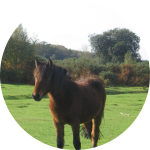| Home |
Welcome to the Horse Stall |
|
Horse Stall contains all types of information for Horse Lovers.
There are a number of products branded horse gifts and products.
Horse Articles :: Asturian Horse
|
Asturian Horse
|
|
The Asturcуn or Asturian horse is an ancient and extremely rare breed of small local pony that originated in the Asturias region of Northern Spain and has inhabited this planet for the past 3000 years. It is said to be the oldest horse species alive and they were highly appreciated by the Roman invaders who referred to them in their texts circa 80 A.D. Pliny (23-79 A.D.) described them as a small breed that did not trot, but moved in an easy gait by alternately moving both legs on one side. The Asturias region covers a little less than 100 square kilometers with a population of around 4.000 people. The ponies live in a feral or wild state, mostly high in the mountains of the Sierra del Sueve, but the largest and most important group is now concentrated in the western part of Asturia. These ponies are hardy and frugal and able to survive in areas where other horse and pony breeds would perish. In the Asturias they are used for working the ground, riding, driving, and trekking as well as pack horses. The exact ancestry of the Asturian horse is unknown, but many believe that it developed from crossing the original Sorraia saddle horse of Iberia with the Garrano pony of Northern Portugal and Spain which is also a direct descendant of the ancient and now extinct Celtic Pony. However, the ambling gait of the Asturian is not present in either the Sorraia or Garrano, so some other horse must have been present in the breed's lineage. Some strains of Celtic pony may have been amblers since there is a small, but clear, trail of ambling horses found in Turkey, China, Mongolia, and Siberia, that can trace the route of the prehistoric Celtic pony to the once available land-bridge at the Bering Straits. The now extinct Spanish Jennet was an ambler and it is probable that the Asturian was the source of the Jennet's gait, rather than the other way around. The Spanish Jennet's gait has spread far beyond Spain and has had a strong influence on many other gaited breeds for which the Asturian receives no lineage credit. The Asturian horse has been referred to by many names over the centuries including being known as its close relative, the Galician, which at one time the Asturian horse was combined with, but presently the Galician is nearly extinct in its pure form. The Asturian horses have also been referred to as palfreys in England. In France, they were called haubini, a word that later became hobbye and eventually as hobby horse throughout Ireland, France and England because of the rocking motion of the ride and was even taken to Ireland to produce the now extinct Irish Hobby Horse that was developed prior to the 13th century. As a result of their comfortable and naturally occurring ambling gait, the Asturian became popular as ladies' mounts. They were popular with the French during the late Middle Ages, but it was after the Spanish civil war, that they started to go into decline. That was when crossbreeding to other horses to obtain more height and weight to increase their market value, both for meat and for work in agriculture started to lead to the decline of the pure breed. The Asturian breed itself has faced the danger of possible and imminent extinction, but recently their plight came to be known in the ecological consciousness of the 1980's and now many societies have been formed protect the pony and ensure its survival as a species. So far, they have managed to curb the breed's dramatic fall. One of these is the Asturcуn Pony Breeding Association (ACPRA) or Asociacion de criadores de poneys de raza Asturcуn, which is a non-profit association in Asturia for promoting, protecting and registering the breed. Another is the Asturian Association of Friends of the Nature (ANN) and they are also being bred at the Asturias Bed and Breakfast among other places. The Asturian is a small equine of horse body type but of pony-size and stands between 11 to 12.2 hands high. The horse has a rather heavy head and a straight profile with small ears and large eyes. The neck is long and quite thin with an abundant flowing mane and a forelock that often grows to cover their eyes for protection from the elements. The withers are moderately high; the straight back is strong with a deep chest and a low tail-set. They have very hard hooves and the breed is seen predominantly in either chestnut or black with no white markings. The last few of these famous Asturian horses can still be seen in the county of Colunga in the Eastern part of Asturias where they are admired greatly and where the annual Fiesta del Asturcуn (Asturian horse festival) is held in Mid-August. It is held in the Espineres Fol., deep in the Sierra del Sueve where the wild Asturian horses are rounded up for culling and branding and various traditional games are played. Some specimens, especially the offspring of the previous year are, marked for re-development and sale or breeding. Once tamed, a noble temperament is seen. This calm, quiet
nature was influenced by their Sorraia ancestry and they are
an ideal pony for children. Their action is soft, simple and
the breed is a natural for jumping. Under harness, they demonstrate
an exceptional aptitude. Author Resource:-> Crystal Eikanger is a writer for http://www.HorseClicks.com, classifieds |
Top Horses |
|
| Top Horse Movies | |
Horse Resources |
|
Horse Health |
|
Horse Breeds |
|
More Horses |
|


| Copyright 2005-2021 DR Management All rights reserved |
Dog Gifts | Wildlife Gifts | Handmade Horse Gifts |
